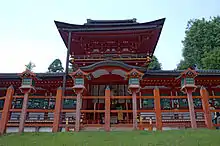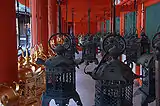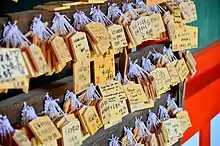Kasuga-taisha
Kasuga-taisha (春日大社) is a Shinto shrine in Nara, Nara Prefecture, Japan.[1] It is the shrine of the Fujiwara family, established in 768 CE and rebuilt several times over the centuries. The interior is famous for its many bronze lanterns, as well as the many stone lanterns that lead up the shrine.
| Kasuga-taisha 春日大社 | |
|---|---|
 The middle gate and hall | |
| Religion | |
| Affiliation | Shinto |
| Deity |
|
| Festival | Kasuga-no-matsuri (Kasuga-sai: 春日祭) (13 March) |
| Type | Twenty-Two Shrines Chokusaisha Beppyo jinja, Shikinaisya Former kanpeitaisha |
| Location | |
| Location | 160 Kasugano-chō, Nara-shi, Nara-ken |
 Shown within Japan | |
| Geographic coordinates | 34°40′53″N 135°50′54″E |
| Architecture | |
| Style | Kasuga-zukuri |
| Date established | 768 |
| Website | |
| www | |
| Part of a series on |
| Shinto |
|---|
 |
The architectural style Kasuga-zukuri takes its name from Kasuga Shrine's honden (sanctuary). The Torii at Kasuga-taisha is one of the oldest in Shinto and helped influence the style of Torii seen across much of Japan. Kasuga Shrine, and the Kasugayama Primeval Forest near it, are registered as a UNESCO World Heritage Site as part of the "Historic Monuments of Ancient Nara".
The path to Kasuga Shrine passes through a deer park. In the park, deer are able to roam freely and are believed to be sacred messengers of the Shinto gods that inhabit the shrine and surrounding mountainous terrain. Kasuga Shrine and the deer have been featured in several paintings and works of art of the Nambokucho Period.[2] Over three thousand stone lanterns line the way. The Man'yo Botanical Garden is adjacent to the shrine.
History
Origin
The birth of this shrine, according to legend, began when the first kami of Kasuga-taisha, Takemikazuchi, rode on the back of a white deer to the top of Mount Mikasa in 768 CE.[3] This kami is said to have traveled from the Kashima Jingu Shrine in order to protect Nara.[4] The shrine location first received favor from the Imperial government in the Heian period as a result of the power from the Fujiwara family as well as Empress Shōtoku.[5]
From 1871 through 1946, Kasuga Shrine was officially designated one of the Kanpei-taisha (官幣大社), meaning that it stood in the first rank of government supported shrines.
Religious significance
The four main kami enshrined here are Ame no koyane, Himegami, Futsunushi no mikoto, and Takemikazuchi no mikoto.[6] Though these are the primary divine beings of Kasuga taisha, they are often grouped together as a syncretic, combined deity known as Kasuga Daimyōjin.[3] Kasuga Daimyōjin is composed of five divine beings and each consists of a Buddhist deity and Shinto kami counterpart. The fifth deity, Ame-no-Oshikumone, was added much later and is said to be the divine child of Ame no koyane and Himegami.[7] The importance of the multifaceted kami was that it became a template for future worshipers who wanted to combine several deities to pray to at once.[8]
Architecture
The architectural style of Kasuga-taisha comes from the name of its main hall (honden) known as Kasuga-zukuri. The shrine complex is protected by four cloisters and contains a main sanctuary, treasure house, several different halls, and large gates. One beautiful aspect of this shrine is the many wisteria trees known as "Sunazuri-no-Fuji" that bloom in late April and early May. This shrine is also home to over 3,000 lanterns which are made of either stone or bronze. An entire hall is devoted to them which is Fujinami-no-ya Hall but the lanterns are only lit during the Setsubun Mantoro and Chugen Mantoro festivals.
The four main kami each have a shrine devoted to them which are all in the same architectural style. They are characterized by sloping gabled roofs, a rectangular structure, katsuogi (decorative logs), and chigi (forked roof structures).[9] The first hall established is dedicated to Takemikazuchi no mikoto, the second to Futsunushi no mikoto, the third to Amenokoyane no mikoto, and the final hall is attributed to the consort, Himegami.[4] Several auxiliary shrines lie outside the main sanctuary that are dedicated to lesser kami. One is allotted to Tsunofuri no kami, that is commonly known as Tsubakimoto Jinja Shrine or Kayabusa Myojin.[5] Kasenomiya Jinja Shrine is attributed to Shinatsuhiko no mikoto and Shinatsuhime who are kami of the winds.[5] Wakamiya Jinja Shrine, created in 1135 CE, is one of the more prominent auxiliary shrines because it houses the kogami, or offspring kami called Ame no Oshikumono no mikoto. The primary worship here revolves around vengeful gods and the dead and is the location of the Kasuga Wakamiya festival.
The Treasure House at this shrine contains hundreds national treasures as well as about many other cultural properties, most of which are from the Heian period.[5] Some of the most noteworthy items that reside here are ornate taiko drums used in gagaku from the Kamakura period, arrows with crystal whistles from the Heian period, and bronze mirrors of the Heian and Nanboku-cho periods.[10]
Kasuga-taisha, like Ise Grand Shrine and Izumo-taisha, continues the tradition of shikinen zōtai (式年造替), the regular rebuilding of shrines. This is a tradition based on the tokowaka (常若) concept of Shinto, in which objects are renewed in order to keep their divine prestige in pursuit of eternity. Like the Ise Grand Shrine, Kasuga-taisha has been rebuilding its shrines to the same specifications every 20 years for more than 1000 years since the Nara period, with the most recent reconstruction being the 60th rebuilding in 2016.[11][12]
Festivals
During the festivals of Setsubun Mantoro (February 3) and Chugen Mantoro (August 14–15), three thousand shrine lanterns are all lit at once. The Setsubun Mantoro refers to the celebration of the seasonal shift from winter to spring while the Chugen Mantoro relates to the transition of summer to fall. They both take place in order to celebrate the Obon and Setsubun holidays in Japanese culture. At Kasuga Grand shrine, people are seen writing and attaching their wishes, or ema, to the lanterns before lighting them during both festivals. Additionally, it is said that tossing dried beans at these times will ward off bad luck in the future.[13]
March 13 is the Kasuga Matsuri, a local festival which features the dances of gagaku and bugaku. Shinto women perform traditional Japanese Yamato-mai dances that date back to the Heian and Nara periods. This festival also holds a horse celebration which consists of a parade through the streets by a "sacred" horse.[14] One will see people dressed in traditional costumes of the Heian to Edo periods and can experience authentic kagura dance displays with dengaku music.
The Kasuga Wakamiya Festival takes place at the Wakamiya Jinja shrine from December 15 to 18th each year. The main goal of this gathering was to ward off disease while promoting new growth for the spring.[15] Like Kasuga Matsuri, attendants can see kagura performances along with a procession in traditional attire.
Kasugayama Primeval Forest
Kasugayama Primeval Forest is primeval forest of about 250 hectares (620 acres) near the summit of Kasugayama (498 metres (1,634 ft)), and contains 175 kinds of trees, 60 bird types, and 1,180 species of insects. In this area adjacent to Kasuga Grand Shrine, hunting and logging have been prohibited since 841 CE. Because Kasugayama has long been tied to Kasuga Grand Shrine worship, it is regarded as a sacred hill. The forest backdrop of the Kasuga Grand Shrine's buildings today has been unchanged since the Nara period.
Images
 Chakutoden
Chakutoden Kurumayadori
Kurumayadori Minamimon
Minamimon Sakadono
Sakadono Heiden, Buden
Heiden, Buden Keishoden
Keishoden A smaller enclave
A smaller enclave Lanterns
Lanterns Corridors in the shrine complex
Corridors in the shrine complex Lanterns
Lanterns Bronze lanterns
Bronze lanterns Bronze lanterns in Kasuga-taisha
Bronze lanterns in Kasuga-taisha Stone lantern leading up to shrine framing a Nara Park deer
Stone lantern leading up to shrine framing a Nara Park deer Tying omikuji at Kasuga Shrine
Tying omikuji at Kasuga Shrine Path leading up to the shrine, braced by rows of stone lanterns
Path leading up to the shrine, braced by rows of stone lanterns Kasuga stone lantern presented in 1997 to Nara sister city, Canberra, Australian Capital Territory
Kasuga stone lantern presented in 1997 to Nara sister city, Canberra, Australian Capital Territory A "breast shrine" at the Kasuga Shrine walk decked with Ema plaques
A "breast shrine" at the Kasuga Shrine walk decked with Ema plaques Ichi-no-Torii
Ichi-no-Torii Armour laced with red threads With bamboo, tiger, sparrow motif; nomination includes the helmet; said to have been dedicated by Minamoto no Yoshitsune; one of two similar armours at Kasuga-taisha 1185 Kamakura period Ō-yoroi
Armour laced with red threads With bamboo, tiger, sparrow motif; nomination includes the helmet; said to have been dedicated by Minamoto no Yoshitsune; one of two similar armours at Kasuga-taisha 1185 Kamakura period Ō-yoroi Hanging lanterns and Andons in the Setsubun Mantoro Festival
Hanging lanterns and Andons in the Setsubun Mantoro Festival Hanging lanterns and Andons in the Setsubun Mantoro Festival. Andons, there are special prayers to the reconstruction and welfare for the victims of the Great East Japan earthquake and the 2011 flood disaster.
Hanging lanterns and Andons in the Setsubun Mantoro Festival. Andons, there are special prayers to the reconstruction and welfare for the victims of the Great East Japan earthquake and the 2011 flood disaster. Hanging lantern designed a dropping wisteria in the Setsubun Mantoro Festival
Hanging lantern designed a dropping wisteria in the Setsubun Mantoro Festival "Sunazuri-no-Fuji", wisteria flowers dropping down to reach the sand on the ground
"Sunazuri-no-Fuji", wisteria flowers dropping down to reach the sand on the ground Shrine maidens in Kasuga-taisha
Shrine maidens in Kasuga-taisha Ema (wishes) in asuga-taisha shrine
Ema (wishes) in asuga-taisha shrine
See also
- List of Shinto shrines
- Twenty-Two Shrines
- List of National Treasures of Japan (crafts-others)
- List of National Treasures of Japan (crafts-swords)
- List of National Treasures of Japan (shrines)
- Deer (mythology)
- Modern system of ranked Shinto Shrines
- Kasuga Maru
- List of Special Places of Scenic Beauty, Special Historic Sites and Special Natural Monuments
References
- Richard, Ponsonby-Fane. (1964), Visiting Famous Shrines in Japan, pp. 221–251.
- Birmingham Museum of Art (2010). Birmingham Museum of Art : guide to the collection. [Birmingham, Ala]: Birmingham Museum of Art. p. 46. ISBN 978-1-904832-77-5.
- Tyler, Royall (2016). The miracles of the Kasuga deity. Columbia University Press. ISBN 9780231534765. OCLC 954193203.
- "Main Sanctuary". www.kasugataisha.or.jp. Archived from the original on 2019-06-24. Retrieved 2019-03-28.
- "世界遺産 春日大社 公式ホームページ". www.kasugataisha.or.jp. Archived from the original on 2007-09-27. Retrieved 2019-03-28.
- Grapard, Allan G. (1992). The protocol of the gods: a study of the Kasuga cult in Japanese history. University of California Press. ISBN 0520070976. OCLC 25873140.
- Ten Grotenhuis, Elizabeth (1999). Japanese mandalas : representations of sacred geography. University of Hawai'i Press. ISBN 0824820002. OCLC 39181008.
- Ashkenazi, Michael (2011). Handbook of Japanese mythology. ABC-CLIO. ISBN 9781849728560. OCLC 755870995.
- Cali, Joseph (2013). Shinto shrines: a guide to the sacred sites of Japan's ancient religion. University of Hawai'i Press. ISBN 9780824837136. OCLC 1043096844.
- 東京国立博物館 -トーハク-. "Eternal Treasures from Kasugataisha Shrine". www.tnm.jp. Retrieved 2019-04-08.
- 常若(とこわか)=伊勢神宮・式年遷宮にみる和のサステナビリティ (in Japanese). Daiwa Institute of Research Ltd. 6 April 2016. Archived from the original on 7 May 2021. Retrieved 5 November 2022.
- 式年造替の本義と若宮御造替 (in Japanese). Kasuga taisha. April 2022. Archived from the original on 30 October 2022. Retrieved 5 November 2022.
- "Setsubun Mantoro | Nara Attractions | Japan Travel | JNTO |". Japan National Tourism Organization (JNTO). Retrieved 2019-04-08.
- Smyers, Karen A.; Bocking, Brian (1997). "A Popular Dictionary of Shinto". Monumenta Nipponica. 52 (3): 419. doi:10.2307/2385644. ISSN 0027-0741. JSTOR 2385644.
- O'Neill, P. G. (2001). Collected writings of P.G. O'Neill = P.G.オニール論文集. Japan Library. ISBN 1873410506. OCLC 46594973.
External links
- Official site in Japanese
- Kasugataisha Shrine, from The Official Nara Travel Guide Archived 2019-08-03 at the Wayback Machine
- Mt. Kasuga Primeval Forest, from The Official Nara Travel Guide Archived 2019-08-03 at the Wayback Machine
- Japan Guide
- New York Public Library Digital Gallery, early photograph of entrance to Kasuga Shrine
- National Diet Library: photo, 1913
- National Archives of Japan: Kasugashinkozu, scroll showing annual festival at Nara Kasuga Grand Shrine (Edo period)